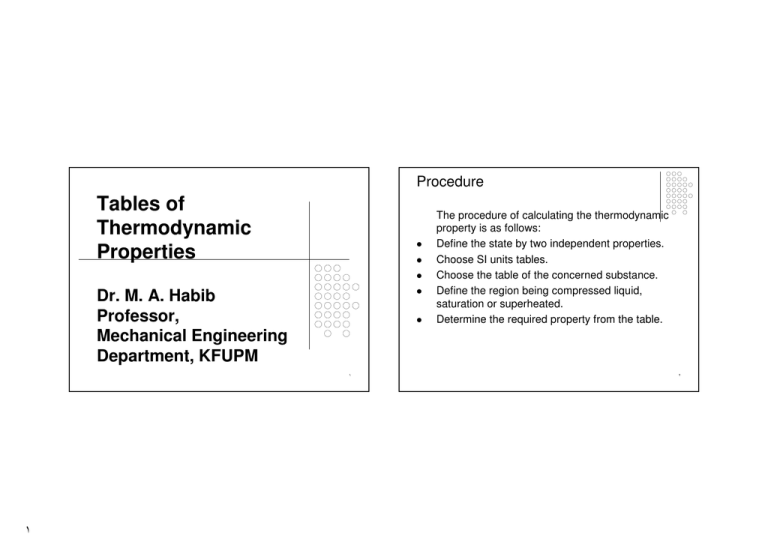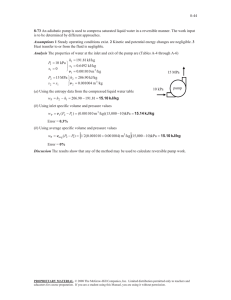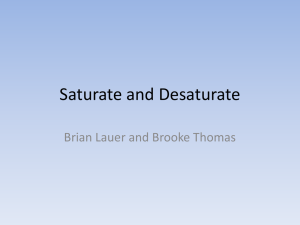Tables of Thermodynamic Properties
advertisement

Procedure Tables of Thermodynamic Properties Dr. M. A. Habib Professor, Mechanical Engineering Department, KFUPM ١ ١ The procedure of calculating the thermodynamic property is as follows: Define the state by two independent properties. Choose SI units tables. Choose the table of the concerned substance. Define the region being compressed liquid, saturation or superheated. Determine the required property from the table. ٢ 3. Calculation of the thermodynamic properties 3.1 Saturation region Defining the state The state is defined by two independent properties. It should be noted that, in the saturation region, P and T are two dependent properties. ٣ ٢ Given T and x Example: Saturation water at T=100 oC and x=0.4. Find P and v. Solution: From saturation table at T=100oC, read P= 101.3 kPa, vf = 0.001044 m3/kg and vfg= 1.67185 m3/kg, then: v= vf + x (vfg) = 0.6698 m3/kg ٤ 3.1 Saturation region 3.1 Saturation region_ Given P,x ٥ ٣ Given P,x Example Saturated water at P= 100 kPa and x=0.6. Find T and v. Solution From saturation table at P=100 kPa read T= 99.62 oC, vf =0.001043 m3/kg and and vfg= 1.67185 m3/kg . Then ٦ 3.1 Saturation region_ Given P,x 3.1 Saturation region_ Given T,v v= vf + x (vfg) = 1.01682 m3/kg ٧ ٤ Given T,v Example Saturated R134a at T=10 oC and v=0.02 m3/kg. Find x and P Solution From saturation table at T=10oC read P= Psat = 415.8 kPa, vf = 0.000794 m3/kg and vfg= 0.04866 m3/kg, then ٨ 3.1 Saturation region_ Given T,v 3.1 Saturation region_ Given P,v x= Example. Saturated water at P=100 kPa and v=0.1m3/kg. Determine T and x. v − vf v fg = ٠0٣٩٤٧ ٩ ٥ Given P,v Solution From saturation table at P=100 kPa read vf = 0.001043 m3/kg and vfg= 1.69296 m3/kg and T= Tsat =99.62 oC. Then: ١٠ 3.1 Saturation region_ Given P,v Given P, T and Given T,v and T > Tc x= ٦ v − vf = 0.05845. v fg ١١ Given P, T Since the pressure and temperature are two dependent properties inside the saturation region, therefore, this state is not inside the saturation region Given T,v and T > Tc The state is not inside the saturation region ١٢ Interpolation Interpolation ,Interpolation is required when the given property is not found but instead it lies between two given values in the tables Example Given saturated water at T= 102 oC, x=0.4. Determine P and v. T, oCP, kPa vf, m3/kg vfg, m3/kg 100 101.3 0.001044 1.67185 105 120.8 0.001047 1.41831 ١٣ ٧ Solution The available table provides only T=100 oC and T= 105oC as shown. Therefore, the student has to create another table having T = 102 oC as shown in the table below. The values P, vf and vfg at 102 oC can be obtained by interpolation. As an example, P102 can be obtained from the following equation: ١٤ Interpolation Superheated Region Superheated region P102 − P100 102 - 100 P - 101.3 102 - 100 = , thus 102 = P105 - P100 105 - 100 120.8 - 101.3 105 - 100 Given P, T Example Water vapor at P=1 MPa, T=300 oC. Calculate v. Thus, P102 =109.1 kPa T, oC 100 102 105 P, kPa 101.3 109.1 120.8 vf, m3/kg 0.001044 0.0010452 0.001047 vfg, m3/kg 1.67185 1.57043 1.41831 T, oC 300 P, kPa v, m3/kg 0.25794 v= vf + x (vfg) = 0.6292 m3/kg ١٥ ٨ ١٦ Superheated Region Superheated Region Solution v=0.25794 m3/kg Given T, v Example Water vapor at T=300 oC, v=0.3 m3/kg. Determine P. Solution T, oC 300 ١٧ ٩ P1=800 kPa v1 , m3/kg 0.32411 P= ? kPa v, m3/kg 0.3 P2=1000kPa v2 , m3/kg 0.25794 ١٨ Superheated Region Superheated Region Interpolation gives: v − v1 P - P1 0.3 - 0.32411 P - 800 = , thus = v 2 - v 1 P2 - P1 0.25794 - 0.32411 1000 - 800 Thus, P = 872.87 kPa ١٩ ١٠ Given P, v Example: R134a vapor at P=0.8 MPa, v=0.035 m3/kg. Determine T. P = 0.8 MPa T1= 90 oC v1 = 0.03394 m3/kg T= ? oC v= 0.035 m3/kg T2= 100 oC v2= 0.03518 m3/kg ٢٠ Superheated Region Double interpolation Solution v − v1 T - T1 0.035 - 0.03394 T - 90 = , thus = 0.03518 - 0.03394 100 - 90 v 2 - v 1 T2 - T1 Thus T= 98.55oC ٢١ ١١ Double interpolation Example Given water at P= 1.1 MPa, T= 220 oC. Solution First, interpolate between v1a and v1b to get v1 Then, interpolate between v2a and v2b to get v2 Then, interpolate between v1 and v2 to get v. ٢٢ Double interpolation Compressed-liquid region T T, oC T1=200 T=220 T2=250 Pa =1.0 MPa v1a =0.20596 v2a =0.23268 P=1.1 Mpa v, m3/kg v1 =0.18763 v=0.197584 v2 =0.21252 Pb==1.2 Mpa v1b=0.1693 v2b =0.19235 ٢٣ ١٢ Given P,T Example: Compressed-liquid water at P=10 MPa and T=100 oC. Find v. Solution: From compressed-liquid table, at P = 10 MPa and T= 100 oC read: v= 0.001039 m3/kg ٢٤ Other Problems (Special cases) Case of compressed liquid water at low pressure Example: Compressed liquid water at P=100 kPa, T=20 oC. Calculate the specific volume. ٢٥ ١٣ Solution: The first available pressure in the compressed liquid table is 5000 kPa. Thus P<< 5000 kPa, therefore, the following approximation will be performed: Using the saturation table, read: v=vf at T= 20 oC, thus v= 0.001002 m3/kg. ٢٦ Compressed liquid table is not available. Compressed liquid table is not available Case of state in the compressed liquid region and the compressed liquid table is not available. Example: Compressed liquid R134a at P=1.0 MPa and T=10 oC. Determine v. Solution ٢٧ ١٤ The compressed-liquid table is not available, therefore, the following approximation will be performed: Using the saturation table, read: v= vf at T=10 oC, thus, v= 0.000794 m3/kg. ٢٨ Close to saturated vapor A state in the superheated region and close to saturated vapor. Example Water vapor at P= 800 kPa and T=180 oC. Determine v. Solution: Interpolation between Saturation temperature and T= 200 oC, thus: ٢٩ ١٥ P, 800 kPa (170.43oC ) T, oC v, m3/kg Sat (T1=170.43oC ) v1= .24043 T= 180oC v = ?? o T2= 200 C v2= 0.2608 v180 − v sat 180 − Tsat = v 200 − v sat 200 − Tsat ٣٠ Defining the region Thus: v - 0.24043 180 - 170.43 = 0.2608 - 0.24043 200 - 170.43 The region in which the state lies is determined by its two independent properties. The following are examples. This section is only concerned with defining the region. Thus v= 0.247 m3/kg ٣١ ١٦ ٣٢ (T, x) OR (P, x) The properties can then be determined according to the procedures given in Section 3 based on the region being compressed liquid, saturation or superheated. ٣٣ ١٧ Given The state has to be inside saturation region because x (having a value between 0 and1) indicates a mixture of liquid and vapor. ٣٤ T, v Given Given T,v From saturation tables, determine vf and vg at T. The region is determined based on the following conditional table: Condition v <vf v >vg vf ≤v ≤ vg Region Compressed liquid region Superheated region Saturation region ٣٥ ١٨ ٣٦ Given T,v Given P, v Example: R134a at T= 0 oC, v= 0.3 m3/kg. Define the region. Solution: At T= 0 oC, vf = 0.000773 m3/kg and vg=0.06919 m3/kg, thus v > vg, then, the state is in superheated region. Given P, v From saturation tables determine vf and vg at Psat = P then: Condition v <vf v >vg ≤ vf v≤vg ٣٧ ١٩ Region Compressed liquid region Superheated region Saturation region ٣٨ P, T Given Given P, v Example: Water at P= 150 kPa, v= 1.0 m3/kg. Define the region. Solution: At P= 150 kPa, read vf=0.001053 m3/kg and vg= 1.15933 m3/kg , Thus vf < v < vg , then the state is in the saturation region. ٢٠ P, T One of two alternative methods can be used as follows: a. Method 1: Starting with temperature: From saturation tables determine Psat at T, then, according to the following table the region can be determined: ٣٩ Given ٤٠ P, T Given Condition P > Psat P < Psat P, T Region Compressed liquid region Superheated region Example: Given Solution: Psat (at T= 40 oC) = 7.384 kPa. Thus, P > Psat, therefore, the state is in the compressed liquid region. Property diagrams for case of P > Psat (The state is in the compressed-liquid region). Water given at 100kPa and 40 oC ٤١ ٢١ ٤٢ P, T Given P, T ٤٣ ٢٢ Given Example R134a at 1.0 MPa and T=50 oC. Define the region. Solution: From saturation tables, determine Psat (at T= 50 oC). Thus Psat = 1318.1 kPa. Therefore, P< Psat. Then, the state is in the superheated region. ٤٤ Property diagrams for case of P < Psat (The state is in the superheated region). Method 2: Starting with temperature ٤٥ ٢٣ b. Method 2: Starting with temperature: From saturation tables determine Tsat at P, then, according to the following table, the region can be determined: Condition Region T > Tsat Superheated region T< Tsat Compressed liquid region ٤٦ Method 2: Starting with temperature Method 2: Starting with temperature Example: Water at 300 oC and P=1 MPa. Define the region. Solution: From saturation table at P=1 MPa, read Tsat = 179.91oC, thus, T > Tsat . The state is in the superheated region. ٤٧ ٢٤ Property diagrams for case of T > TThe ( sat .)state is in the superheated region ٤٨ Method 2: Starting with temperature Method 2: Starting with temperature Example Water at 200 oC and P=3 MPa. Define the region. Solution From saturation table at P= 3MPa get Tsat = 233.9. Thus, T< Tsat. Therefore, the state is in the compressed-liquid region. ٤٩ ٢٥ Property diagrams for case of T < Tsat (The state is in the compressed-liquid region. ٥٠ Constant-volume process Thermodynamic processes for a system The following are examples of constant property processes of a system. Work = = zero Constant-pressure process Work = ٥١ ٢٦ ∫ pdv = zero ٥٢ Isothermal process (T=constant) Process following the relation Pv = constant Work)real substance = Work = ٢٧ ∫ pdv = p1v1 ln v2 v1 ∫ pdv = ? Work)ideal gas = ∫ pdv = p1v1 ln [P-v relation is not available]. ٥٣ ٥٤ v2 v1 Spring-controlled Process p=cv 1.1 Polytropic process Pvn = c Work = Work = area under process = ∫ pdv = p 2 v 2 − p1v1 1− n P1 + P2 (v2-v1) 2 ٥٥ ٢٨ ∫ pdv = ٥٦ Defining the region for u, h, or s Isentropic Process Real substance Work = ∫ pdv =?? [p-v relation Relation is not available]. ٢٩ Ideal gas (cp = constant), Pvk=c P v − P1 v 1 Work = ∫ pdv = 2 2 1− k ٥٧ Given T, h From saturation tables, determine vf and vg at Tsat=T. Then use the following table to determine the region. Condition h <hf h >hg hf ≤h≤ hg Region Compressed liquid region Superheated region Saturation region ٥٨ Given P, h Calculation of properties for given u, h, s Given P, h From saturation tables determine hf and hg at Psat = P. Then use the following table to determine the region. Condition h <hf h >hg hf ≤ h ≤ hg Region Compressed liquid region Superheated region Saturation region ٥٩ ٣٠ Saturation region Given T, h Example. Water T=200 oC, h=1500 kJ/kg. Calculate P and x (if the state is in the saturation region). ٦٠ Given P, h Saturation region Solution From saturation table it can be found that hf < h < hg, thus the state is in the saturation region. At T=100oC read P= Psat, hf = 852.43 kJ/kg and hfg= 1940.75 kJ/kg. Thus, P= Psat =1.5538 MPa x= h − hf h fg = 0.3337 ٦١ ٣١ Given P, h Example. R134a at P=120 kPa , h=200 kJ/kg. Calculate T and x (if the state is in the saturation region). Solution From saturation table it can be found that hf < h < hg, thus the state is in the saturation region. From saturation table at P=120 kPa try to read T= Tsat, hf and hfg ٦٢ Given P, h Given P, h In this case, because P=120 kPa is not given in the table, interpolation has to be performed between P=107.2 kPa and P=133.7 kPa to create a row of data at P=120 kPa as shown in the following table: T -25 -22.58 -20 ٣٢ hf 167.38 170.45 173.74 hfg 215.57 214.0 212.34 Thus, from this table, T= Tsat = -22.58 oC and x= ٦٣ P 107.2 120 133.7 h − hf 200 − 170.45 = = 0.1381. h fg 214.0 ٦٤ Superheated region Given T, h h − h1 P − P1 = . h 2 − h1 P2 − P1 Given T, h R134a at T=100 oC, h= 467 kJ/kg Thus P1= 2000 kPa h1= 471 kJ/kg P? h = 467 kJ/kg P2= 2500 kPa h2 = 463.28 kJ/kg h − 471 P − 2000 = 463.28 − 471 2500 − 2000 Substituting for h=467 kJ/kg gives P=2259.1 kPa. ٦٥ ٣٣ ٦٦ P, h Given P, h T − T1 h − h1 = T2 − T1 h 2 − h1 Given P, h Water P=1 MPa, h=3000 kJ/kg. Calculate T T, oC T1= 250 T? T2= 300 Given P = 1Mpa h, kJ/kg h1= 2942.59 h= 3000 kJ/kg h2= 3051.15 thus T − 250 h − 2942.59 = 300 − 250 3051.15 − 2942.59 Substituting for h=3000 kJ/kg gives T=276.4 oC ٦٧ ٣٤ ٦٨ Compressed liquid region pressure is very low Given P, T Example Compressed-liquid water at P=10 MPa, T=100 oC. Calculate h Solution From the compressed-liquid table, get h= 426.48 kJ/kg. ٦٩ ٣٥ Given P, T and the pressure is very low or the compressed liquid tables are not available The following approximation can be done: u= uf h= hf + vf (P2-Psat at T) ٧٠ pressure is very low Example R 134a at P= 1MPa, T=10oC. Calculate h. Solution h= hf + vf (P2-Psat at T), thus, h= 213.58+ 0.000794(1000-415.8)= 214.04 kJ/kg. ٧١ ٣٦




